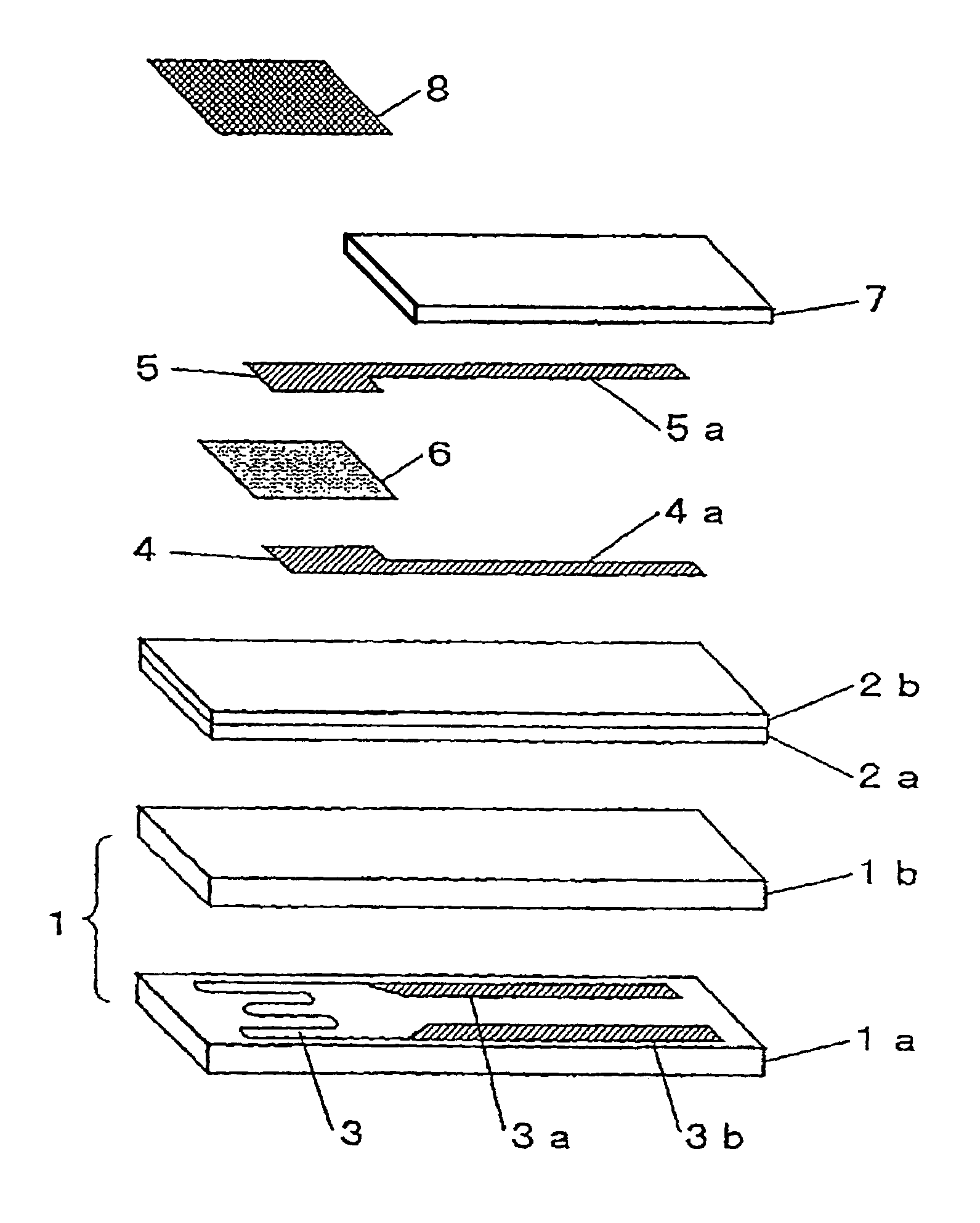Solid electrolyte containing insulating grains for gas sensor
a solid electrolyte and gas sensor technology, applied in the field of electrolyte, can solve the problems of degrading the electrochemical function of the fired solid electrolyte, and achieve the effect of suppressing the formation of cracks
- Summary
- Abstract
- Description
- Claims
- Application Information
AI Technical Summary
Benefits of technology
Problems solved by technology
Method used
Image
Examples
example 1
[0104]A gas sensor element of a reference-oxygen self-generation type was fabricated. The fabrication procedure will be understood with reference to FIG. 1, which schematically shows the gas sensor element in an exploded or rather disassembled manner.
[0105](1) Fabrication of an Alumina Green Sheet Which Becomes a Substrate Upon Firing
[0106]Butyral resin and dibutyl phthalate with respectively predetermined amounts were added to alumina powder serving as an insulating ceramic to thereby prepare a paste. The paste was sheeted through doctor-blading to obtain an alumina green sheet (a) which became a substrate (1a) upon firing and an alumina green sheet (b) which became a substrate (1b) upon firing, each serving as an unfired substrate and having a thickness of 0.4 mm. The substrates (1a), (1b) constitute an alumina substrate (1).
[0107](2) Formation of Heater Pattern
[0108]An alumina-containing platinum paste was applied onto the surface of the alumina green sheet so as to form a heater...
example 2
[0122]Gas sensor elements were fabricated and studied for the interrelation between the alumina content of the oxygen-ion conductive solid electrolyte layer and the internal resistance of the oxygen-ion conductive solid electrolyte layer.
[0123]Alumina powder with 99.997% purity and zirconia material powder with 99.95% purity, which contained 5.5% by mole yttria were mixed according to Table 1. To the resultant mixture, butyl carbitol, dibutyl phthalate, a dispersant, and an organic binder with the respectively predetermined amounts were added to thereby prepare a zirconia paste. By using the zirconia paste, gas sensor elements (1) to (14) were fabricated in a manner similar to that of Example 1. The gas sensor elements (1) to (14) were fitted into respective protection tubes and were exposed to combustion gas generated by combustion of town gas while the heater embedded in the alumina substrate was not energized. On the basis of sensor output, the internal resistance of some gas sen...
example 3
[0127]Autoclave Durability Test:
[0128]Fired gas sensor elements (1) to (14) obtained through steps (1) to (8) of Example 1 were placed in an autoclave for 6 hours at a temperature of 200° C. a humidity of 100%, and a pressure of 15 atm. Subsequently, water-soluble red ink was applied to the gas sensor elements (1) to (14) so as to color cracks, if caused, thereby evaluating durability thereof. The results are shown in Table 1. In Table 1, “O” indicates that no cracks were generated, and “X” indicates that cracks were generated.
[0129]As seen from Table 1, by employing an alumina content range specified in the present invention, cracking does not occur.
PUM
| Property | Measurement | Unit |
|---|---|---|
| thickness | aaaaa | aaaaa |
| grain size | aaaaa | aaaaa |
| grain size | aaaaa | aaaaa |
Abstract
Description
Claims
Application Information
 Login to View More
Login to View More - R&D
- Intellectual Property
- Life Sciences
- Materials
- Tech Scout
- Unparalleled Data Quality
- Higher Quality Content
- 60% Fewer Hallucinations
Browse by: Latest US Patents, China's latest patents, Technical Efficacy Thesaurus, Application Domain, Technology Topic, Popular Technical Reports.
© 2025 PatSnap. All rights reserved.Legal|Privacy policy|Modern Slavery Act Transparency Statement|Sitemap|About US| Contact US: help@patsnap.com



